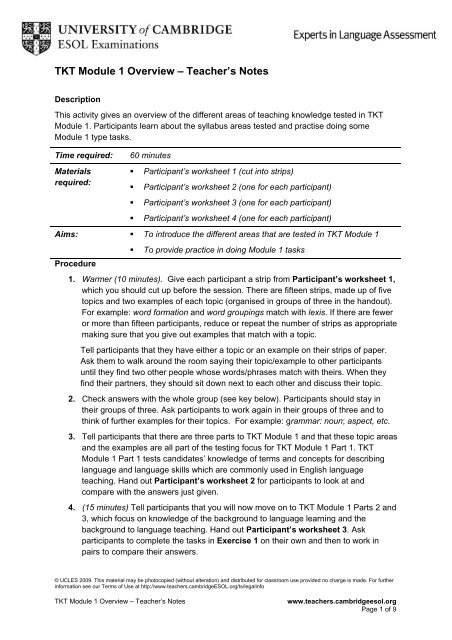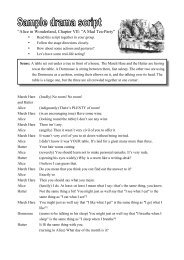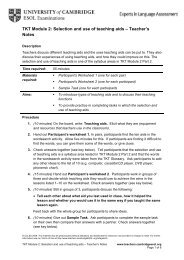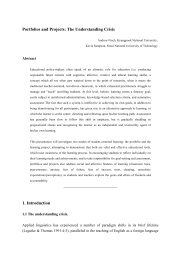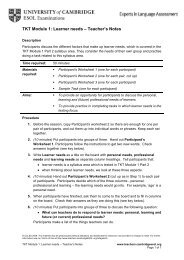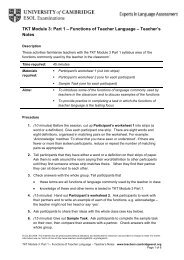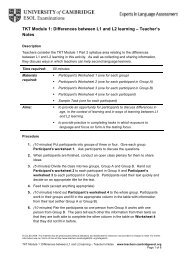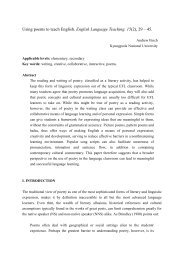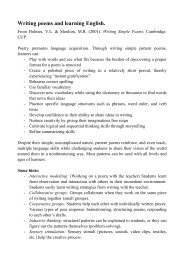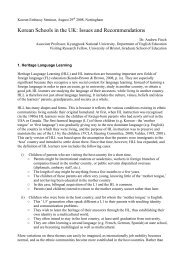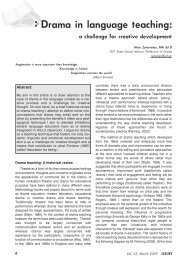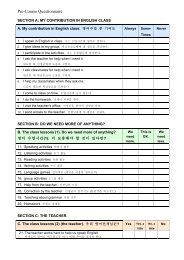TKT Module 1 Overview â Teacher's Notes - Finchpark
TKT Module 1 Overview â Teacher's Notes - Finchpark
TKT Module 1 Overview â Teacher's Notes - Finchpark
Create successful ePaper yourself
Turn your PDF publications into a flip-book with our unique Google optimized e-Paper software.
<strong>TKT</strong> <strong>Module</strong> 1 <strong>Overview</strong> – Teacher’s <strong>Notes</strong>DescriptionThis activity gives an overview of the different areas of teaching knowledge tested in <strong>TKT</strong><strong>Module</strong> 1. Participants learn about the syllabus areas tested and practise doing some<strong>Module</strong> 1 type tasks.Time required:Materialsrequired:60 minutes• Participant’s worksheet 1 (cut into strips)• Participant’s worksheet 2 (one for each participant)• Participant’s worksheet 3 (one for each participant)• Participant’s worksheet 4 (one for each participant)Aims: • To introduce the different areas that are tested in <strong>TKT</strong> <strong>Module</strong> 1Procedure• To provide practice in doing <strong>Module</strong> 1 tasks1. Warmer (10 minutes). Give each participant a strip from Participant’s worksheet 1,which you should cut up before the session. There are fifteen strips, made up of fivetopics and two examples of each topic (organised in groups of three in the handout).For example: word formation and word groupings match with lexis. If there are feweror more than fifteen participants, reduce or repeat the number of strips as appropriatemaking sure that you give out examples that match with a topic.Tell participants that they have either a topic or an example on their strips of paper.Ask them to walk around the room saying their topic/example to other participantsuntil they find two other people whose words/phrases match with theirs. When theyfind their partners, they should sit down next to each other and discuss their topic.2. Check answers with the whole group (see key below). Participants should stay intheir groups of three. Ask participants to work again in their groups of three and tothink of further examples for their topics. For example: grammar: noun; aspect, etc.3. Tell participants that there are three parts to <strong>TKT</strong> <strong>Module</strong> 1 and that these topic areasand the examples are all part of the testing focus for <strong>TKT</strong> <strong>Module</strong> 1 Part 1. <strong>TKT</strong><strong>Module</strong> 1 Part 1 tests candidates’ knowledge of terms and concepts for describinglanguage and language skills which are commonly used in English languageteaching. Hand out Participant’s worksheet 2 for participants to look at andcompare with the answers just given.4. (15 minutes) Tell participants that you will now move on to <strong>TKT</strong> <strong>Module</strong> 1 Parts 2 and3, which focus on knowledge of the background to language learning and thebackground to language teaching. Hand out Participant’s worksheet 3. Askparticipants to complete the tasks in Exercise 1 on their own and then to work inpairs to compare their answers.© UCLES 2009. This material may be photocopied (without alteration) and distributed for classroom use provided no charge is made. For furtherinformation see our Terms of Use at http://www.teachers.cambridgeESOL.org/ts/legalinfo<strong>TKT</strong> <strong>Module</strong> 1 <strong>Overview</strong> – Teacher’s <strong>Notes</strong>www.teachers.cambridgeesol.orgPage 1 of 9
5. Give out the answer key on Participant’s worksheet 4 for participants to check theiranswers.6. (15 minutes). In pairs, participants look at Exercise 2 on Participant’s worksheet 3and look at the different example tasks again. They should choose from the box thesyllabus area being focused on in each of the example tasks (A–H). There may bemore than one syllabus area covered by example task. These are the syllabus areascovered in Parts 2 and 3 of <strong>TKT</strong> <strong>Module</strong> 1.7. Check answers together (see key below). Accept additional answers if participantscan justify them.8. (15 minutes) Participants have now overviewed all three Parts of <strong>TKT</strong> <strong>Module</strong> 1.Refer them to Exercise 3 on Participant’s worksheet 4. In groups of three, theyshould decide if the statements about <strong>TKT</strong> <strong>Module</strong> 1 are True or False.9. Check answers together (see key below).10. Round up (5 minutes) Summarise points covered by asking:• How many parts are there to <strong>Module</strong> 1? (three)• What do the three parts focus on? (Part 1: terms for describing language andlanguage skills; Part 2: knowledge of factors in the language learning process;Part 3: knowledge of methods, activities and tasks used in language teaching)• How long is the test and how many questions are there in the test? (1 hour20 minutes; 80 questions)• Do candidates write long answers? (No, the tasks are all objective, e.g.multiple choice, matching)• How do candidates record their answers? (They mark their answers on ananswer sheet by shading the correct lozenge. They are advised to do this as theycomplete each task. There is no additional time provided to fill in the answersheet at the end.)© UCLES 2009. This material may be photocopied (without alteration) and distributed for classroom use provided no charge is made. For furtherinformation see our Terms of Use at http://www.teachers.cambridgeESOL.org/ts/legalinfo<strong>TKT</strong> <strong>Module</strong> 1 <strong>Overview</strong> – Teacher’s <strong>Notes</strong>www.teachers.cambridgeesol.orgPage 2 of 9
<strong>TKT</strong> <strong>Module</strong> 1 <strong>Overview</strong> – Answer KeysKey to Procedure Step 2• Grammar: parts of speech; the forms and use of grammatical structures• Lexis: word formation, e.g. prefixes, suffixes, compounds; words groupings, e.g.synonyms, antonyms• Phonology: symbols from the International Phonetic Alphabet (IPA); phonemes, wordstress, sentence stress, intonation and connected speech• Functions: a range of functions and their typical exponents; levels of formality infunctional language• Language skills: reading, listening, speaking, writing; features of written and spokentext, e.g. layout, organisation, accuracy, fluencyKey to Participant’s Worksheet 3Exercise 1Task 1Task 2Task 3Task 4Task 51. B1. C1. B1. B1. C2. E2. B2. C2. D2. A3. A3. A3. C3. B4. DExercise 2/ Procedure Step 7Task 1Task 2Task 3Task 4Task 5A, C, EGHF, BE, AKey to Participant’s Worksheet 4Exercise 3/ Procedure Step 91. False. <strong>Module</strong> 1 consists of three parts.2. True3. True4. False. There are 80 questions© UCLES 2009. This material may be photocopied (without alteration) and distributed for classroom use provided no charge is made. For furtherinformation see our Terms of Use at http://www.teachers.cambridgeESOL.org/ts/legalinfo<strong>TKT</strong> <strong>Module</strong> 1 <strong>Overview</strong> – Answer Keyswww.teachers.cambridgeesol.orgPage 3 of 9
<strong>TKT</strong> <strong>Module</strong> 1 <strong>Overview</strong> – Participant’s Worksheet 2<strong>Module</strong> 1 Part 1<strong>TKT</strong> <strong>Module</strong> 1 Part 1 tests candidates’ knowledge of terms and concepts common in Englishlanguage teaching that are used to describe language and its use and language skills andsubskills.There are 6–8 tasks consisting of 40 questions.Candidates need to demonstrate an understanding of concepts and terminologyrelated to:Syllabus areaGrammarLexisPossible testing focus• parts of speechthe forms and use of grammatical structures• types of meaning• word formation, e.g. prefixes, suffixes, compounds• words groupings, e.g. synonyms, antonyms, lexical sets,homophones, collocation• registerPhonology• symbols from the International Phonetic Alphabet (IPA)• phonemes, word stress, sentence stress, intonation and connectedspeechFunctions• context• levels of formality• appropriacy• a range of functions and their typical exponentsLanguage skills• reading, listening, speaking, writing• features of written and spoken text, e.g. layout, organisation,accuracy, fluency, authenticity© UCLES 2009. This material may be photocopied (without alteration) and distributed for classroom use provided no charge is made. For furtherinformation see our Terms of Use at http://www.teachers.cambridgeESOL.org/ts/legalinfo<strong>TKT</strong> <strong>Module</strong> 1 <strong>Overview</strong> – Participant’s Worksheet 2www.teachers.cambridgeesol.orgPage 6 of 9
<strong>TKT</strong> <strong>Module</strong> 1 <strong>Overview</strong> – Participant’s Worksheet 3Exercise 1Complete the following examples of <strong>Module</strong> 1 Part 2 and Part 3 tasks.Task 1: Match the questions (1–4) with the options (A–E). There is one extra optionwhich you do not need to use.ABuild up learners’ confidence in theirabilities1At the start of the class, the teacherwrites on the board what she hopes thelearners will achieve in the lesson.BMake the learning aims clear tolearners2The teacher introduces a new topic byusing situations from learners’ own lives.C Encourage learner autonomy 3The teacher gives only positivefeedback on language.DEAsk learners about their learningpreferencesPersonalise lessons4The teacher finds out how and when thelearners like to be corrected.Task 2: Choose the most appropriate answer to the questions.1 Which of these does not involve putting things in order?ABCrankingjumbled paragraphslabelling2 What of these does not involve pair or group work?ABCjigsaw readingchoral repetitioninformation gapTask 3: Match the questions (1–3) with the options (A–D). There is one extra optionwhich you do not need to use.1 To put students into a class at the correct level A progress test2 To help students evaluate their own progress B placement test3 To give students a test on language taught in the lastunit of their coursebookCDself-assessmentdiagnostic test© UCLES 2009. This material may be photocopied (without alteration) and distributed for classroom use provided no charge is made. For furtherinformation see our Terms of Use at http://www.teachers.cambridgeESOL.org/ts/legalinfo<strong>TKT</strong> <strong>Module</strong> 1 <strong>Overview</strong> – Participant’s Worksheet 3www.teachers.cambridgeesol.orgPage 7 of 9
Task 4: Match the questions (1–3) with the options (A–D). There is one extra optionwhich you do not need to use.ABGrammar TranslationTask-based learning (TBL)1Lessons focus on completing an activity afterwhich relevant language is highlighted andworked on.C Total Physical Response (TPR) 2Learners practise new structures orally onlyafter the teacher has introduced them.DPresentation, Practice andProduction (PPP)3Learners perform actions in response to theteacher’s instructions.Task 5: Match the questions (1–3) with the options (A–D). There is one extra optionwhich you do not need to use.ABThe learner enjoys practisinglanguage in pairs and groups.The learner doesn’t want theteacher to explain grammar.1‘Most of the time should be spent doinggrammar exercises.’CThe learner enjoys doinglanguage practice that focuses onaccuracy.2‘I prefer working with other students to speakingto the teacher in front of the class.’DThe learner wants explanations ofgrammar rules.3‘Rules just confuse me – it’s better to work outlanguage from context.’Exercise 2Which syllabus area is being tested in the example tasks above? You may find thateach task focuses on more than one syllabus area.A motivation E learner characteristics/learner needsBexposure to language and focus onformFpresentation techniques and introductoryactivitiesC the role of error G types of activities and tasks for languageand skills developmentDdifferences between L1 and L2learningHassessment types and tasks© UCLES 2009. This material may be photocopied (without alteration) and distributed for classroom use provided no charge is made. For furtherinformation see our Terms of Use at http://www.teachers.cambridgeESOL.org/ts/legalinfo<strong>TKT</strong> <strong>Module</strong> 1 <strong>Overview</strong> – Participant’s Worksheet 3www.teachers.cambridgeesol.orgPage 8 of 9
<strong>TKT</strong> <strong>Module</strong> 1 <strong>Overview</strong> – Participant’s Worksheet 4Answer key to Participant’s Worksheet 3 Exercise 1Check your answers with the key to the example tasks.Task 1Task 2Task 3Task 4Task 51. B1. C1. B1. B1. C2. E2. B2. C2. D2. A3. A3. A3. C3. B4. DExercise 3Look at the following statements about <strong>TKT</strong> <strong>Module</strong> 1. Talk with a partner and say if youthink they are True or False.<strong>TKT</strong> <strong>Module</strong> 11. consists of two parts.2. candidates have 1 hour and 20 minutes to do the test.3. tasks are in the form of multiple choice tasks, odd-one out tasks, matching tasks.4. has 100 questions to answer in the test.<strong>TKT</strong> <strong>Module</strong> 1 tests knowledge of5. grammar, lexis, phonology and functions.6. the skills of writing, reading, listening and speaking.7. phonemic script.8. the background to language learning.9. the accuracy of teachers’ language use.10. how to design materials for the classroom.11. a range of methods, tasks and activities.12. the terms used to describe language.© UCLES 2009. This material may be photocopied (without alteration) and distributed for classroom use provided no charge is made. For furtherinformation see our Terms of Use at http://www.teachers.cambridgeESOL.org/ts/legalinfo<strong>TKT</strong> <strong>Module</strong> 1 <strong>Overview</strong> – Participant’s Worksheet 4www.teachers.cambridgeesol.orgPage 9 of 9


